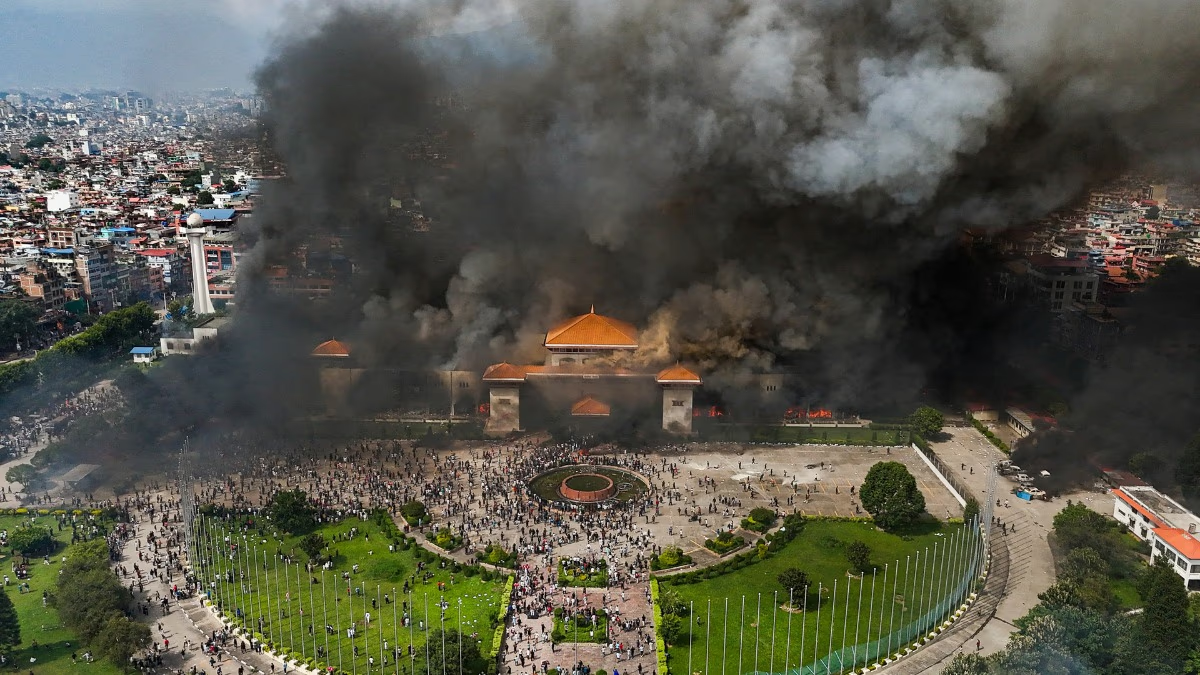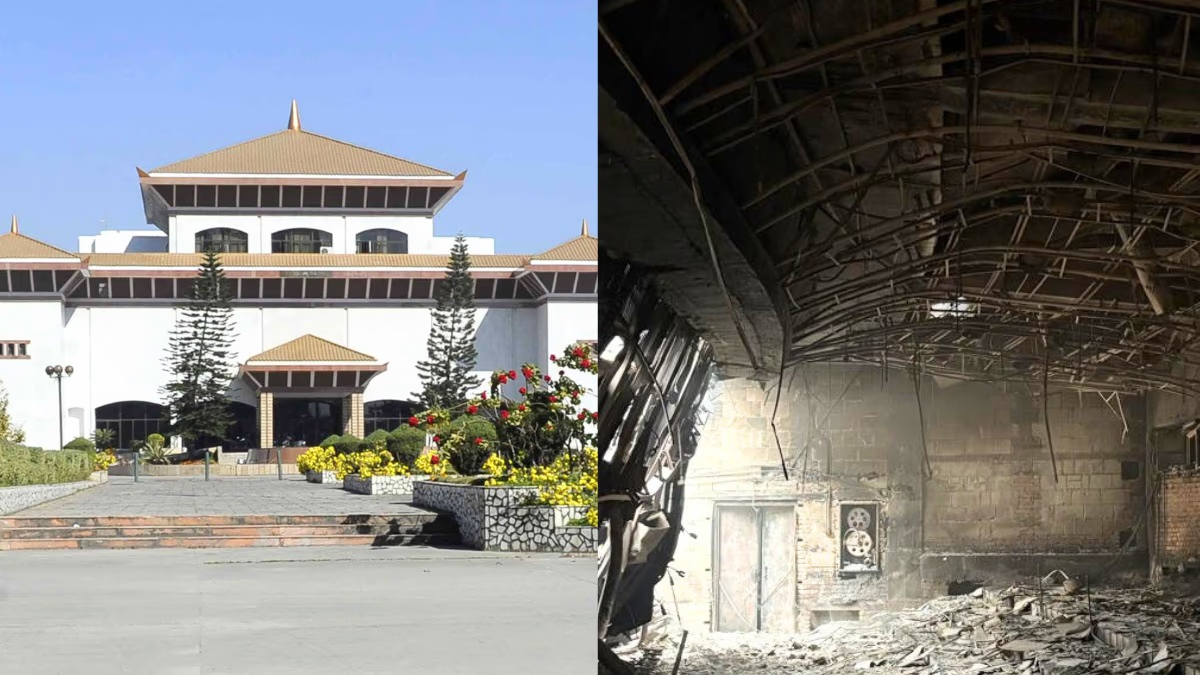During his three-day visit to the United States, opposition leader Rahul Gandhi made significant comments about the employment situation in India. He compared India with China, stating that India's lack of focus on production has led to employment issues.
Rahul Gandhi said, 'China focused on production within its country. Hence, they don’t face employment issues. Most items in India are 'Made in China'. This policy helps China successfully create employment.'
He also discussed the manufacturing sector. Rahul said, 'Just one or two individuals are being handed all ports and defense contracts, leading to the struggles in India's manufacturing sector.'
Contrary to Rahul’s statement, India’s manufacturing sector has seen significant growth in recent years. It is projected that by 2030, 'Made in India' exports will reach $1 trillion. How expansive is India’s manufacturing industry? How many jobs does it create? And how can it outpace China? Let's find out.
India and Manufacturing
- Before Independence:
Most products were handmade and sold globally. The first attempt to make iron by burning wood charcoal began in 1830 in Tamil Nadu. In 1868, Jamsetji Tata founded the Tata Group. During World Wars I and II, industrial growth in India accelerated to assist the British.
- Post-Independence (1948-91):
India focused on industry through its five-year plans. An industrial policy was enacted in 1956. Subsequently, there was rapid growth in iron, steel, heavy engineering, and fertilizer industries. However, the License Raj stifled government factory productivity.
- Post-1991 Reforms:
In 1991, India opened its economy, ending the License Raj and making way for private industries. Despite this, more emphasis was on services rather than goods, affecting industrial production growth rates negatively. Nonetheless, the government promoted manufacturing via MSMEs.
- From 2014 to 2024:
The Modi government introduced the 'Make in India' initiative in 2014. This aimed to transform India into a manufacturing hub. The PLI scheme was launched to offer incentives to companies. Corporate taxes were reduced, and the Mudra Scheme was initiated to promote the MSME sector.
How Large is India's Manufacturing Sector?
The manufacturing sector contributes 17% to India’s GDP. According to IBEF, from June 2022 to June 2024, India’s manufacturing industry grew by 40%.
A Colliers report from December 2023 predicts that India’s manufacturing sector will surpass $1 trillion by 2025-26.
According to the Commerce Ministry, India exported $776.68 billion worth of goods in 2023-24, of which $437 billion came from the manufacturing sector. Manufacturing exports saw a 3% decline from 2022-23, where it stood at $451 billion.
Foreign Direct Investment (FDI) in the manufacturing sector has also risen rapidly. The central government informed Parliament in August that the sector attracted over $165 billion in FDI between 2014 and 2024, compared to about $98 billion between 2004 and 2014—showing a 69% growth in FDI.
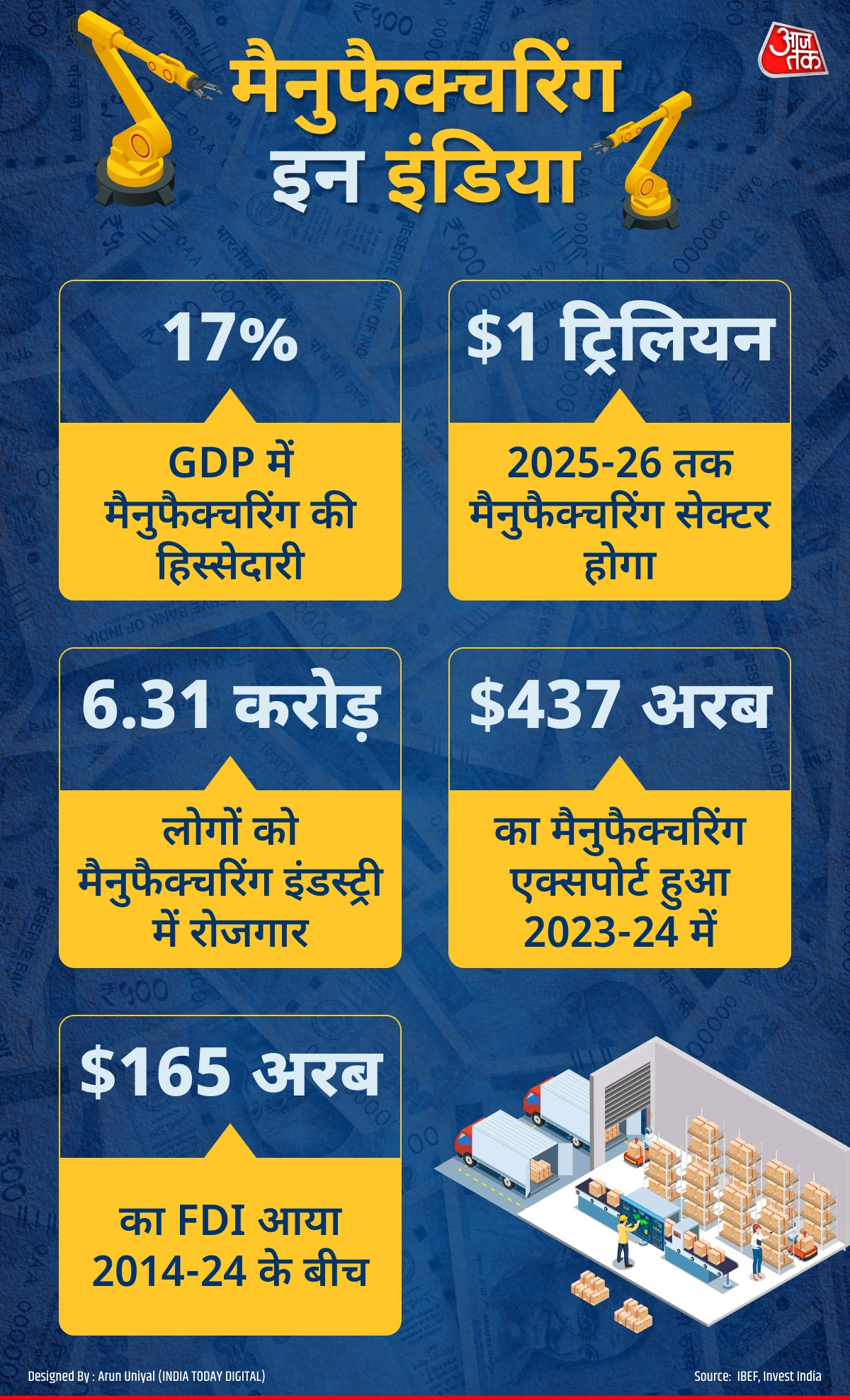
Source: aajtak
How Many Jobs Does the Manufacturing Sector Create?
Employment in India’s manufacturing sector has increased by 114% over four decades. A recent RBI report indicates that from 1980-81, when 29.5 million Indians worked in manufacturing, the number rose to 63.1 million by 2022-23. The manufacturing sector accounts for 10% of all employment in India.
According to the central government, over 30% of employment in the MSME sector comes from manufacturing. Statistics show that 35% of jobs are in trade, and 32% are in manufacturing within the sector.
A report from Indeed in July claimed that new job opportunities in India’s manufacturing sector are emerging rapidly. Indeed’s Sales Head, Sashi Kumar, believes since India aims to become a global manufacturing hub, opportunities abound for both businesses and job seekers in this sector.
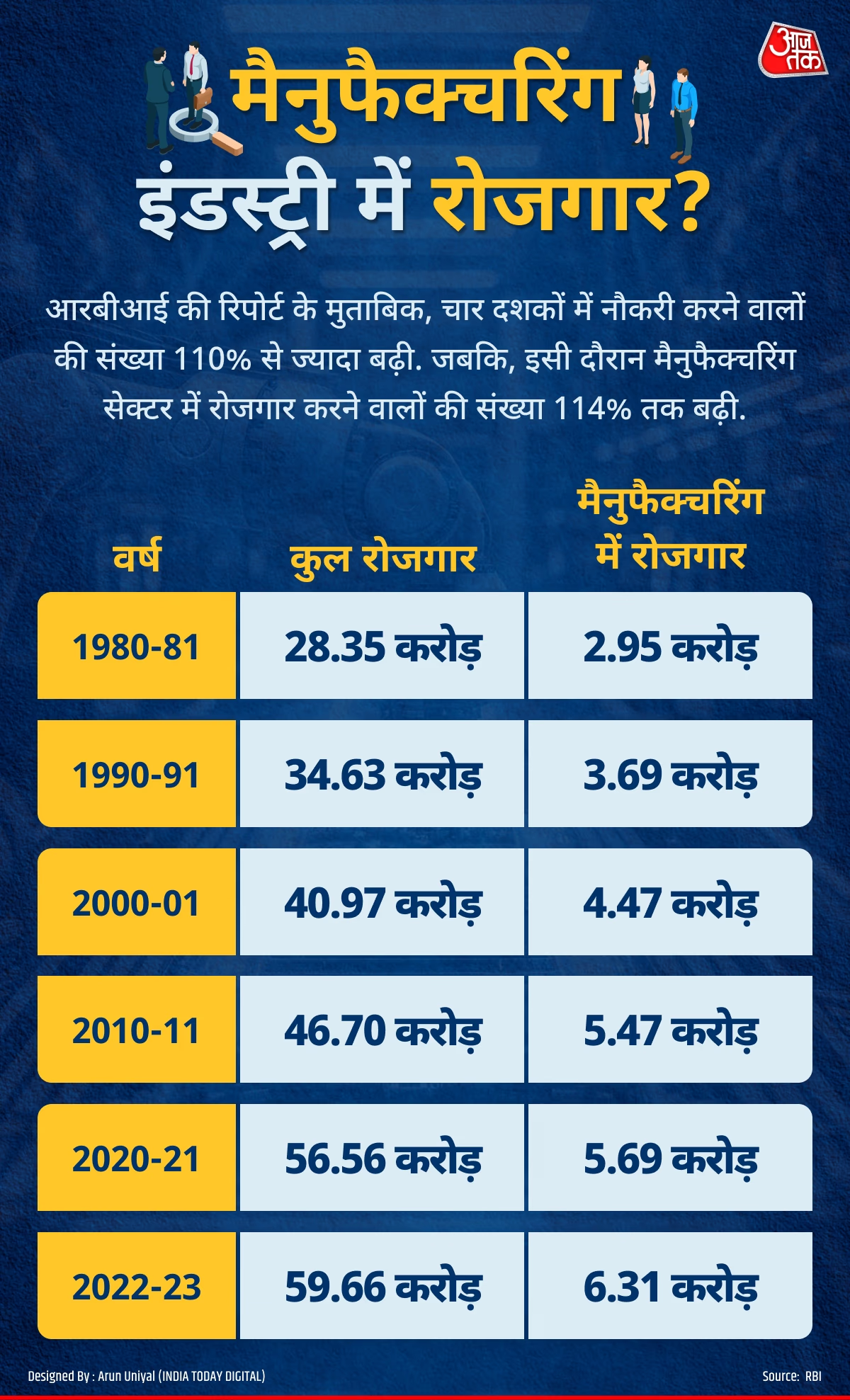
Source: aajtak
Can India Compete with China?
As of today, India’s economic condition mirrors that of China in 2007. According to the World Bank, China’s GDP in 2007 was $3.5 trillion—similar to India's current GDP. In 2007, China’s per capita income was around $2,700, as opposed to India’s current per capita income of approximately $2,500.
China’s significant economic growth happened post-2008 when it started attracting youth to the manufacturing sector, leading to reduced agricultural employment and increased industrial employment.
But now, India is also emerging as a manufacturing hub. Presently, the manufacturing contribution to GDP is 17%, with the objective to raise it to 25% by 2025.
Recent years have seen several major companies turning towards India due to China-related tensions and trade wars. Defense and electronics manufacturing hold substantial potential. India aimed at $5 billion in defense exports by 2025 and projected the electronics manufacturing sector to reach $300 billion by 2030. Top companies like Amazon and Apple have already invested in Indian manufacturing.
Last year, when Apple announced setting up a manufacturing plant in India, China's Global Times called it a major concern.
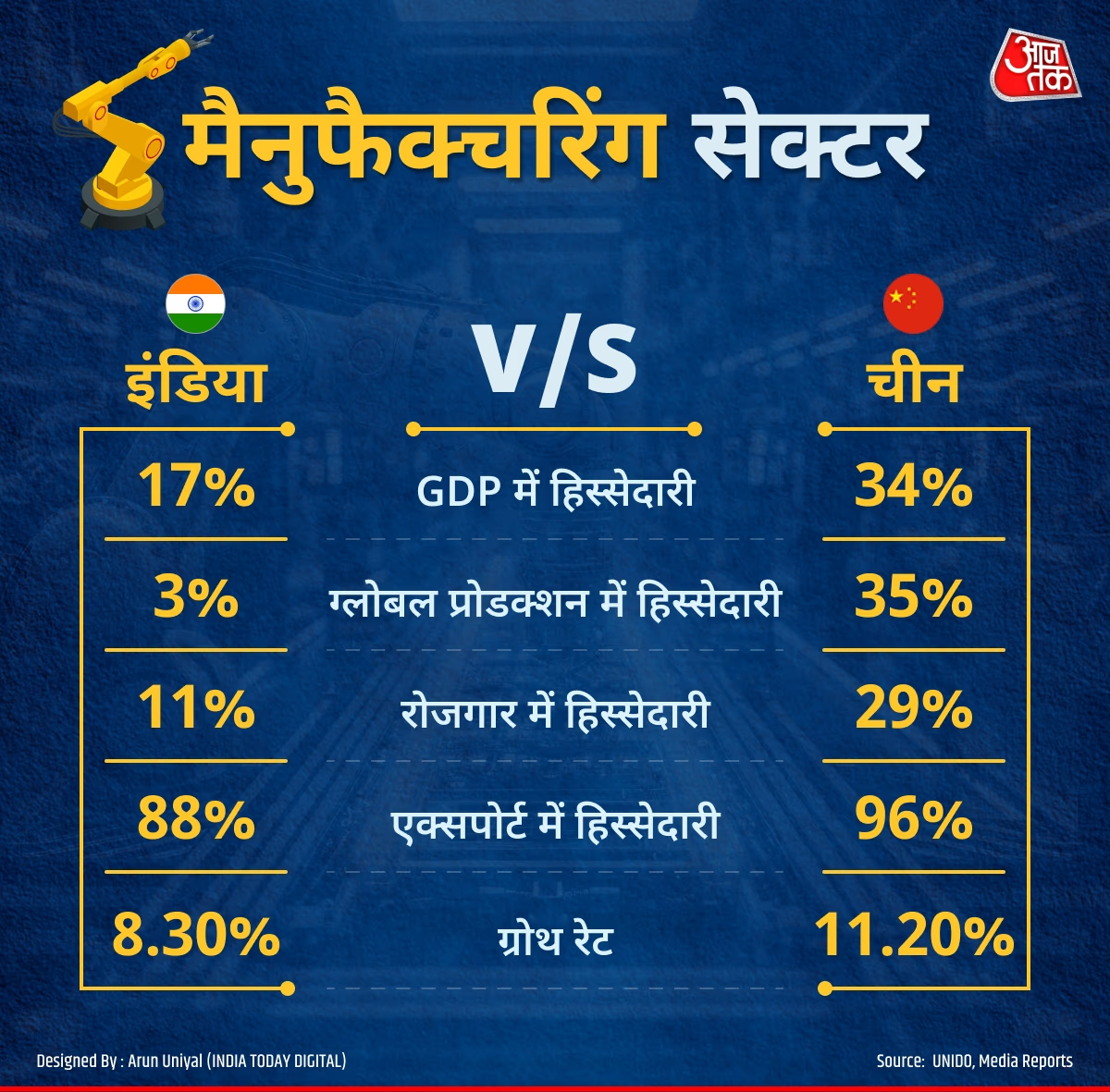
Source: aajtak
Last year's Colliers report claimed Gujarat has the potential to emerge as the largest manufacturing hub. The report identified Gujarat, Maharashtra, and Tamil Nadu as top destinations for investment.
Gujarat stands out due to affordable land for industrial development, good connectivity, and government incentives. Maharashtra offers excellent infrastructure and subsidies for setting up industries. Tamil Nadu provides low labor costs along with subsidies and incentives for industries.
In conclusion, India stands poised to outpace China. With lower labor costs and strong infrastructure compared to China, the government plans to invest over ₹11 lakh crore in infrastructure over the next five years. Programs like Make in India, Skill India, and Startup India further bolster this progress.
For India to become a major manufacturing hub, it's vital to reduce import duties on manufacturing components. According to the WTO, India's average import duty on components is 18%, compared to China’s 7.5%. Similarly, customs clearance takes an average of 20 hours in China, while in India, it ranges from 44 to 85 hours.
Experts believe that aside from surpassing China, India must also outshine Vietnam, which is currently the primary choice for many global manufacturing companies over India.


